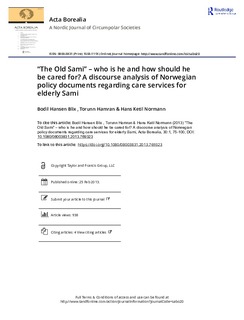| dc.contributor.author | Blix, Bodil Hansen | |
| dc.contributor.author | Hamran, Torunn | |
| dc.contributor.author | Normann, Hans Ketil | |
| dc.date.accessioned | 2017-06-07T12:36:46Z | |
| dc.date.available | 2017-06-07T12:36:46Z | |
| dc.date.issued | 2013 | |
| dc.identifier.citation | Blix, B.H., Hamran, T. & Normann, H.K. (2013) “The Old Sami” – who is he and how should he be cared for?: a discourse analysis of Norwegian policy documents regarding care services for elderly Sami. Acta Borealia, 30(1), s. 75-100. | |
| dc.identifier.uri | http://hdl.handle.net/11250/2444846 | |
| dc.description | Vitenskapelig artikkel basert på en diskursanalyse av fire offentlige dokumenter vedrørende helse- og omsorgstjenester til samiske eldre. | |
| dc.description.abstract | This study examined four policy documents published by the Norwegian government from 1995 to 2009 describing issues regarding the provision of public services to elderly Sami in Norway. Adopting a Foucauldian discourse analytic approach, we explored how the statements regarding elderly Sami and care services in these documents are situated within contemporary ethnopolitical and healthcare discourses. The documents exhibited two major and interrelated trends: the predominant portrayal of the Sami and the ethos of cultural congruent care. The analysis demonstrated a high degree of discursive continuity throughout the four documents, with the image of the elderly Sami constructed in the earliest document reproduced to a large extent in the newer documents. We suggest that a critical cultural perspective offers an alternative to the understanding of culture and the concept of cultural congruent care found in the documents. Froma critical cultural perspective, culture is seen as relational, changing over time, and dependent on social context, history, gender, and other factors. In this view, cultural competence does not involve learning a fixed, coherent body of knowledge comprising ‘‘the Sami culture’’. A critical cultural perspective challenges those who provide care to the elderly Sami to become aware of social, political, and historical processes while simultaneously acknowledging that the impacts of these processes on the lives of the individuals they encounter can never be fully known. Furthermore, this perspective prompts healthcare providers to reflect on how their assumptions about the people they encounter are shaped by their own social, cultural, economic, and professional backgrounds. We suggest that the authorities initiate a new policy document based on current insights into the everyday experiences of the current cohort of elderly Sami as well as contemporary social, ethno-political, and healthcare discourses. | |
| dc.description.sponsorship | NFR | |
| dc.language.iso | eng | |
| dc.subject | sami | |
| dc.subject | Norway | |
| dc.subject | political documents | |
| dc.subject | discourse analysis | |
| dc.subject | elderly | |
| dc.subject | health care | |
| dc.subject | samer | |
| dc.subject | Norge | |
| dc.subject | politiske dokumenter | |
| dc.subject | diskursanalyse | |
| dc.subject | eldre | |
| dc.subject | helse- og omsorgstjenester | |
| dc.title | “The Old Sami” – who is he and how should he be cared for?: a discourse analysis of Norwegian policy documents regarding care services for elderly Sami | |
| dc.type | Journal article | |
| dc.type | Peer reviewed | |
| dc.rights.holder | Blix, Bodil Hansen | |
| dc.source.volume | 30 | |
| dc.source.journal | Acta Borealia | |
| dc.source.issue | 1 | |
| dc.identifier.doi | 10.1080/08003831.2013.769323 | |
